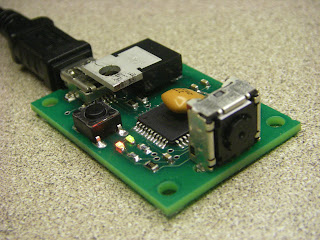
Here's the pinout thanks to kako and a PCB picture. The Reset pin is active low, so use a pullup resistor to Vcc. The Wiimote runs the camera with a 25Mhz clock, but it also works with a 20Mhz clock so you might get away with fudging this a bit. The I2C communication is fast 400Khz and the slave device address is 0xB0. Most microcontroller development platforms should include I2C communication capabilities. If yours doesn't, get a better dev kit =o). Desoldering the camera can be hard with so many pins. But, careful use of a hot air gun will do the trick. The first part is to initialize the camera over I2C. Here's the pseudo code for initializing to maximum sensitivity (actual CCS C code in comments):
- write(hex): B0 30 01
- wait 100ms
- write(hex): B0 00 00 00 00 00 00 00 90 //sensitivity part 1
- wait 100ms
- write (hex): B0 07 00 41 //sensitivity part 2
- wait 100ms
- write(hex): B0 1A 40 00 //sensitivity part 3
- wait 100ms
- write(hex): B0 33 03 //sets the mode
- wait 100ms
- write(hex): B0 30 08
- wait 100ms
It's still somewhat mysterious to me what all these mean, but in this mess is the sensitivity and mode settings described at Wiibrew. The above code uses the sensitivity setting suggested by inio "00 00 00 00 00 00 90 00 41, 40 00" experssed in the 2nd, 3rd, and 4th message. The wait times are conservatively long. After you initialize, you can now read samples from it:
- write(hex): B0 37 //prepare for reading
- wait 25us
- write(hex): B1 //read request
- read 8 bytes
- wait 380us
- write(hex): B1 //read request
- read 4 bytes
This yeilds one sample from the camera containing 12 bytes, 3 for each of the 4 potential points. The format of the data will be the Extended Mode (X,Y, Y 2-msb, X 2-msb, Size 4-bits). The wait timings approximate what the Wiimote does. I've called this routine 1000 times per second without ill effect. Though, I doubt this is actually scanning the sensor and instead is just reporting the contents of an interal buffer. But, people claim 200Hz updates are possible. So, you can use that as a suggestion.
Hooking this up to your microcontroller is pretty straight forward. Give the camera 3.3v power using a voltage regulator, ground, a 20-25Mhz clock, and connect the SDA and SCL lines (don't forget your pull up resistors), and pull up the reset pin.
The CCS C Compiler for the PIC18F4550 includes USB-HID sample code. It's simply a matter of stuffing the data you got from the PixArt camera into the input report buffers for the USB. With this, you could actually create a USB mouse profile and make it control the cursor without any software or drivers at all. If set it up as a full speed device, it's possible to get 1ms reports providing extremely low latency updates. CCS provides relatively affordable PIC programmers as well. Explaining how to set all this up is not within the scope of this post, but it should be plenty to get you started. If you want to make a PCB, you can try ExpressPCB which can get you boards in-hand for as low as $60.
Update 9/6/08: Just a note about the clock. Since my PIC was using a 20Mhz resonator, I just piggy backed the Pixart clock pin off the OSC2/CLKO pin of the PIC which seemed to work fine. Also, Kako has more details (in Japanese) on doing this with an Arduino





